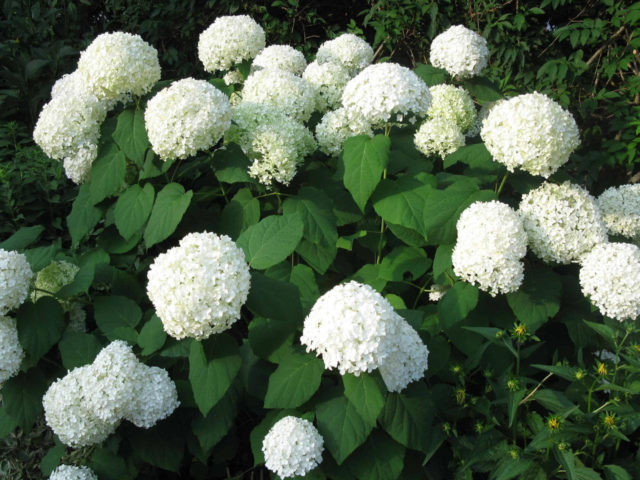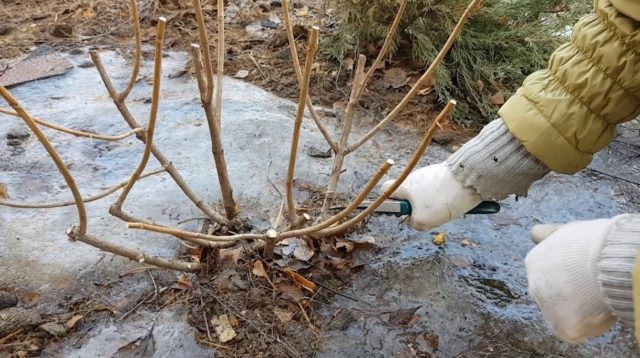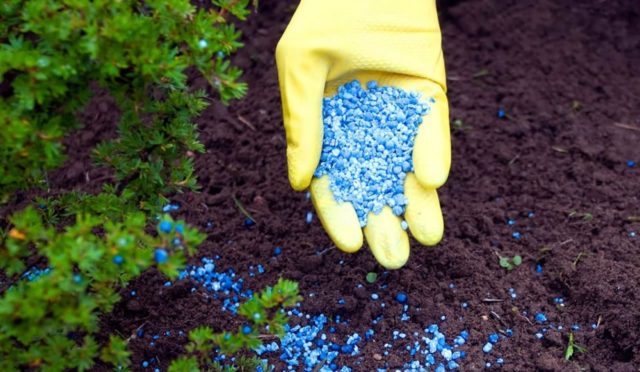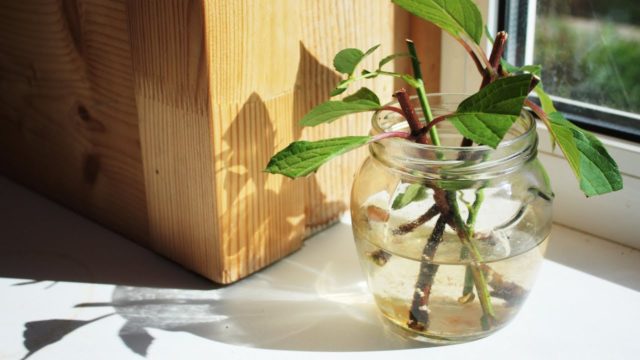Content
Pruning hydrangeas in a tree-like spring is an important step in year-round plant care. Treelike hydrangea is a shrub that reaches a height of 1 to 2.5 meters. The culture has large heart-shaped leaves and lush spherical inflorescences.

Blooming hydrangea exudes a pleasant aroma, which is used in perfumery compositions
Do I need to prune a tree hydrangea in spring
Pruning is a procedure aimed at more than just creating a certain shape of the bush. Shearing is necessary to rid the plant of unnecessary shoots and branches.
There are several types of pruning:
- Thinning or shaping pruning is aimed at creating a crown and giving the bush a decorative shape. Helps to form a neat appearance of the seedling.
- Rejuvenating pruning is carried out once every 5-7 years. Restores the plant, allowing it to sprout large amounts of new growth. This pruning involves the removal of old shoots to the very root.
- Sanitary pruning is designed to eliminate defects in the bush caused by environmental influences. During the procedure, dry branches and inflorescences are removed.
Why do you need to prune a tree hydrangea in spring
It is very important to cut the hydrangea tree-like in time and correctly in the spring. During this period, it is easy to distinguish live branches from dry ones. Kidneys swell on living ones, dry ones break off when pressed. The procedure is carried out for the following purposes:
- to give the bush a neat shape;
- for the formation of dense and large inflorescences;
- pruning is necessary so that the hydrangea is less sick and attacked by pests;
- in several years it turns out to achieve the desired shape and size of the bush;
- any pruning rejuvenates the bushes and provokes the growth of new shoots. In hydrangea, tree-like inflorescences are formed only on new shoots, so you can get rid of old ones without much hesitation. They will still go into greenery and will only spoil the appearance of the plant;
- to avoid freezing. Fresh cuts are the most sensitive areas of hydrangeas to frost. Spring pruning almost completely eliminates this danger.
If the shrub is started, it will quickly thicken, and the inflorescences are crushed and thinned. It will be difficult to return such a sapling to its former luxurious appearance. Therefore, regular pruning is mandatory, you cannot even skip one season.
When to prune your tree hydrangea in spring
In the spring, the time for pruning a tree hydrangea is quite limited, but if all the manipulations are carried out in time, it will only benefit the flower.
It is customary to cut the bushes in early spring, when the snow has not yet completely melted. Usually this is the second or third week of March, in colder areas - the end of March or the first decade of April. If you are late, the places of the cuts will begin to “cry” and die off. Treelike hydrangea will hurt and stop blooming.

Snowy thawed patches around the stems are a sure signal that the plant has already "woken up"
It is very important to follow the procedure correctly:
- you can start work only when the growth buds swell. After all, they are the main reference point for "awakening". But the leaves of them should not be visible;
- take into account the weather conditions during spring pruning.If the cold does not want to go away, and the kidneys are swollen, it is better to wait a couple of weeks for the warming, but you cannot drag it out too much. Otherwise, a sufficient number of new shoots will not have time to form;
How to prune a tree hydrangea
So that the plant does not suffer, and pruning is good for it, it is important to remember a few mandatory rules before the procedure:
- if the bush is young, then the first 2-3 years pruning in spring and autumn is not carried out. It is possible to carry out light sanitary pruning of shoots that are too long. So the hydrangea grows well and hardens in the soil;
- trimming is done with a pruner, the cut is made slightly beveled;
It is advisable to immediately treat fresh cuts with ash or wood resin.
- the bush must first be thinned out, otherwise it will be difficult to get to the main parts;
- healthy shoots are shortened by ½ the length, 2-3 pairs of buds are left on each;
- weak and dry branches are cut at a height of about 10-13 cm from the ground;
- frozen branches are removed to live wood;
- pruning should capture excess shoots in the central part, which create shade and unwanted density;
- if the bush is very old and more than seven years old, then to rejuvenate and accelerate growth, the shoots are cut close to the soil;
- if necessary, fix the trimmed remains of the stems with a support.
The correct step-by-step pruning of a tree hydrangea in spring is shown in the video for beginners.
Hydrangea tree care after spring pruning
After properly pruning, hydrangea needs quality and consistent care. A plant needs a lot of strength to grow new shoots and bloom. It is important to help him with this:
- tree hydrangea loves mineral fertilizers. They provide the flower with all the necessary substances. They are introduced into the soil in the spring when loosening to a depth of several centimeters. As they dissolve, minerals will actively flow to the roots;
Excessive fertilization can poison the delicate hydrangea, as well as provoke the death of the bush.
- top dressing with manure, humus or chicken droppings (diluted with water 1: 1) will work wonders with the bush. The procedure will enhance metabolic processes in stems and roots;
- mulching (covering the soil under bushes) will retain moisture and create a comfortable temperature for good growth and development of new shoots in the spring, as well as protect against pests and get rid of weeds in the summer. Mowed grass, sawdust, needles are suitable as a material;
- tree hydrangea requires abundant watering. Sufficient saturation of the soil with moisture is the key to a lush crown and good flowering throughout the summer;
- the ground around the bushes must be periodically loosened in the spring. It will not take much time, but it will increase the air exchange of the roots and improve the absorption of nutrients. Loosening is carried out carefully, since the root system of the hydrangea tree is located at the surface. It is important not to damage it. For these purposes, a plastic hoe or a small shovel is suitable. Metal tools can cut through thin roots.
Experienced gardening tips
For those who have just planted a tree hydrangea in their garden and are not yet familiar with the intricacies of care and pruning, the advice of experienced summer residents and gardeners will be useful. When growing hydrangeas, some recommendations should be considered:
- Spring pruning of the bush is best done in the evening. So all damaged shoots will have time to drag on by morning, and the flower will not experience severe stress.
- If the shoots are too thick and, after pruning in the spring, juice is abundantly released from them, then it is better to cover the sections with paint or garden pitch. This will help the bushes to avoid infection.
- It is necessary to cut the shoot in one press of the secateurs. If it does not work out, then you can use a file, but this is done only in extreme cases.
- Cut cuttings do not need to be thrown away.Freshly removed shoots are incised along the upper and lower bud, retreating from the edge of 2 cm. The upper cut is made straight, and the lower one - at a slight angle. After that, the branches are placed in a container with water, you can add a little growth stimulant. After two weeks, when the branches take root, they can be planted in a greenhouse (even in spring).Attention! With abundant watering and care, several new specimens will appear on the site by the end of summer.
In the spring, cuttings of hydrangeas are more likely to sprout on a sunny windowsill.
- If hydrangea grows on chernozem soil (southern Russia), then the following mineral fertilizers are suitable for it: manganese potassium solution, urea, ammonium nitrate, ammonium sulfate. It is worth distinguishing between the use of industrial and natural fertilizers. They should be entered at weekly intervals.
- Hortense loves indirect sunlight. If, after pruning, the plant is provided with suitable light conditions (sun in the morning and evening, and in the daytime partial shade), then it will grow and bloom faster.
- Do not plant tree hydrangea next to large trees or other large shrubs. Plants will compete for moisture. With such neighbors, after pruning in the spring, hydrangea can dry out due to insufficient soil moisture.
Conclusion
Pruning hydrangeas in a tree-like spring is not a big deal. If you follow all the recommendations and follow the rules, then the shrub will delight the owner of the site with abundant flowering for more than 15 years.











